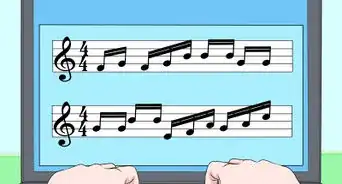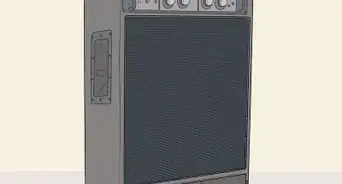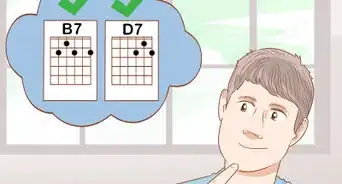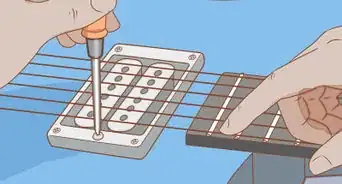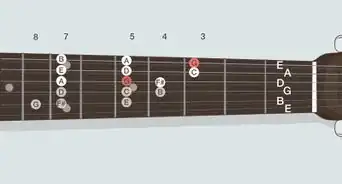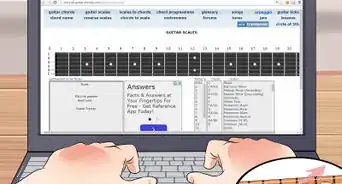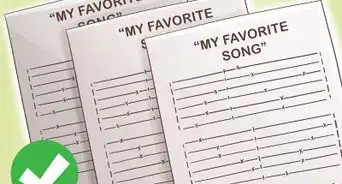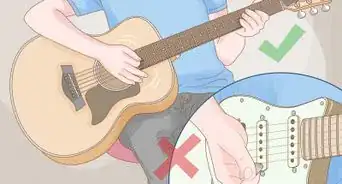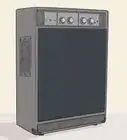This article was co-authored by Nicolas Adams. Nicolas Adams is a 5th generation musician of Serbian Gypsy descent and the lead guitarist of the band Gypsy Tribe. Based in the San Francisco Bay Area, Nicolas specializes in Rumba Flamenco and Gypsy jazz and playing the guitar, Bouzouki, Balalaika, and piano.
This article has been viewed 112,201 times.
One of the most fundamental, yet still difficult, skill for beginning guitarists is figuring out how to position their fingers. Many beginners feel like their fingers hurt, or they struggle to get a solid, ringing note when they hold notes or chords. But with a few simple tricks and some patience, you can improve you playing with proper finger positioning.
Steps
Hand Positioning
-
1Relax your wrist, gripping the neck of the guitar in the "C" formed between thumb and fingers. Your wrist should feel relaxed and free to move. Many guitarists angle their fingers slightly towards their body, instead of trying to hold their wrist at a rigid 90-degree angle. All of your fingers should be able to easily hit a fret on every string.
- If your hands are too small for this reach at first, that is okay. They make smaller guitars for smaller hands, but you'll also learn to pivot your wrist to make all the frets accessible.
EXPERT TIPNicolas Adams is a 5th generation musician of Serbian Gypsy descent and the lead guitarist of the band Gypsy Tribe. Based in the San Francisco Bay Area, Nicolas specializes in Rumba Flamenco and Gypsy jazz and playing the guitar, Bouzouki, Balalaika, and piano.Professional Guitarist
 Nicolas Adams
Nicolas Adams
Professional GuitaristConsider the whole position of your body. For strumming, the best way to position yourself is to try to get your shoulder a little forward, so it's not quite parallel with the bridge and saddle. Then, hold your elbow so it's parallel with the six string, or the low E. You can then adjust accordingly for flatpicking, rest strokes, or playing classical style guitar.
-
2Curl your fingers whenever you're playing a note. You want to be able to press down on a fret with your fingertips. So set yourself up so you can effectively bend your fingers to keep unplayed strings exposed. You want your fingertip on the string, leaving the rest of your finger curling away from the strings. This is essential for effective chords, as well as a lot of lead playing.Advertisement
-
3Keep your fingers close to the fretboard to improve speed and precision. While inadvertent, many beginners let their fingers relax away from the neck when they aren't using them. But watch a professional guitarist and you see that their fingers, even ones they aren't using, are always nice and close to the strings, ready to fret. This is a habit worth training early on.
-
4Use your thumb pushing on the back of the neck to provide power and stability. You don't want to be clamping down too hard on the neck, but you also don't want to leave it loose. A firm grip allowing you to "pinch" the strings down on the neck will help you hold notes, chords, and manipulate the strings for bends and slides.
-
5Roll or rotate your wrist to help get up and down the fretboard. As you play, your thumb will be sliding up and down, almost hooking over the top of the neck when you're on the low strings and sliding down as you reach up for the top strings. If your keep your wrist relaxed and mobile you'll find finger positioning much, much easier.[1]
Fretting Notes Effectively
-
1Angle your fingertips in towards the fret to position precisely. The hard little part of your fingertip, just to the sides of the nail, is a small, precise location to fret with. The fleshy part of your finger will work, but it will be harder to get a clean note and it is much easier to accidentally mute other strings. Angle your hand and fingers slightly so this hard part of your fingertips is hitting the strings.
-
2Always position your finger as close to the fret as possible. If you're playing a note on the 3rd fret, get your finger as close to the 3rd fret as you possibly can. This allows the cleanest, sharpest tone. You don't want to be on the actual fret, just right behind it.
- Remember, if you're playing the 3rd fret you want to be between the 2nd and 3rd frets, you finger as close to the 3rd as possible.
-
3Use your non-fretting fingers to dampen or mute unused strings. This is a slightly more advanced technique, but is a key way to position your fingers. You can minimize mistakes by letting unused fingers rest lightly on the strings, which prevents them from sounding out if they accidentally get picked. Frequently this involves lightly draping your index finger behind the frets you're using.
-
4Experiment with different heights for your barring fingers. When playing a barre chord, when one finger covers multiple strings and frets, is often the bane of new players. If some of the notes in your bar won't stay down, and always buzz when played, adjust how high you set your finger. Most people start with the tip of their finger on the top string of the barre. But this doesn't always work. Place your bar so that your finger joints don't leave any strings exposed.
-
5Practice shifting back and forth between two chords to practice quick positioning. If there is a chord you struggle to fret with speed, work on shifting to it from a chord you are already comfortable with. Slowly, waiting until you can comfortably play each chord with no bum notes, strum along and switch back and forth between the two chords to build up finger strength, speed, and precision.[2]
Expert Q&A
-
QuestionHow do you place your hands on a guitar?
 Nicolas AdamsNicolas Adams is a 5th generation musician of Serbian Gypsy descent and the lead guitarist of the band Gypsy Tribe. Based in the San Francisco Bay Area, Nicolas specializes in Rumba Flamenco and Gypsy jazz and playing the guitar, Bouzouki, Balalaika, and piano.
Nicolas AdamsNicolas Adams is a 5th generation musician of Serbian Gypsy descent and the lead guitarist of the band Gypsy Tribe. Based in the San Francisco Bay Area, Nicolas specializes in Rumba Flamenco and Gypsy jazz and playing the guitar, Bouzouki, Balalaika, and piano.
Professional Guitarist Hold your right hand not directly over the sound hole, and not all the way back towards the bridge, or the saddle. There are certain sweet spots, and every sweet spot gives you a different tone. If you play over the sound hole, it's going to be more of a kind of ambience, gentle sound. If you play back towards the soundboard and towards the saddle, it's going to be harsher. As for the neck and the fingerboard, the heel of your left thumb should always be in a comfortable position - it's likely to be the first thing to get sore when you're learning how to play guitar. And you always want your fingers to have full flexibility and mobility around the fingerboard. Guitar necks may have a different width, so you need to find your own adjustment.
Hold your right hand not directly over the sound hole, and not all the way back towards the bridge, or the saddle. There are certain sweet spots, and every sweet spot gives you a different tone. If you play over the sound hole, it's going to be more of a kind of ambience, gentle sound. If you play back towards the soundboard and towards the saddle, it's going to be harsher. As for the neck and the fingerboard, the heel of your left thumb should always be in a comfortable position - it's likely to be the first thing to get sore when you're learning how to play guitar. And you always want your fingers to have full flexibility and mobility around the fingerboard. Guitar necks may have a different width, so you need to find your own adjustment. -
QuestionDoes this tutorial also work for the ukulele?
 Community AnswerNo. If you want more information about the ukulele, I would read through wikiHow's article on playing the ukulele.
Community AnswerNo. If you want more information about the ukulele, I would read through wikiHow's article on playing the ukulele. -
QuestionHow can I learn to play the guitar well within a week or two?
 GrahamsterCommunity AnswerPlaying guitar "well" is different from person to person, but it is unreasonable to expect to be proficient at playing guitar within a week or two. The guitar is not an easy instrument, it takes time and dedication to properly learn. With a several hours of practice a day, you could probably fake knowing how to play guitar within two weeks, but you will not have learned how to actually play guitar.
GrahamsterCommunity AnswerPlaying guitar "well" is different from person to person, but it is unreasonable to expect to be proficient at playing guitar within a week or two. The guitar is not an easy instrument, it takes time and dedication to properly learn. With a several hours of practice a day, you could probably fake knowing how to play guitar within two weeks, but you will not have learned how to actually play guitar.
References
About This Article
One of the trickiest skills for a beginner guitarist is positioning their fingers on the strings, but with a little patience and a few simple tricks, you can improve your playing quickly. Relax your wrist as you grip the neck of the guitar, and make sure that all of your fingers can easily hit a fret on every string. Whenever you’re playing a note, curl your fingers so you press on the fret with your fingertips. Use your thumb pushing on the back of the neck to add more power and stability. You’ll also want to keep your fingers close to the fretboard to improve your speed and precision. To learn how to fret notes effectively, keep reading!


